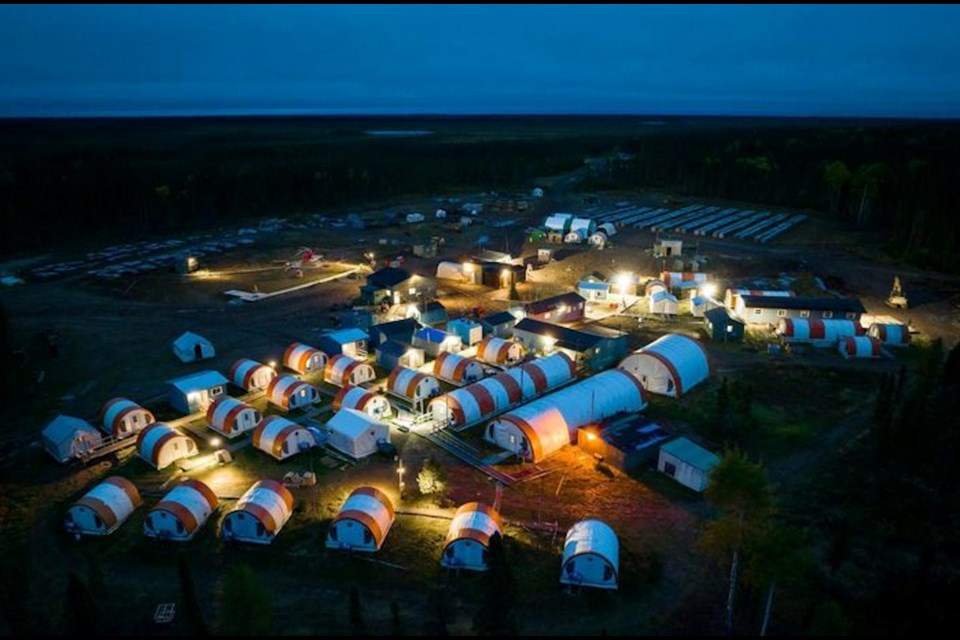The proposed Eagle’s Nest mine will “set a new benchmark for what mining could look like” in the Ring of Fire, said its Australian developer.
Luca Giacovazzi, CEO of Wyloo Metals and a director with Ring of Fire Metals (formerly Noront Resources), revealed some of their innovative engineering solutions last week at the Diggers and Dealers Mining Forum, a leading industry bash held at Kalgoorlie in Western Australia.
Wyloo, the mine investment fund-turned-exploration and mine-building outfit, is out to produce the world’s “greenest nickel” with a stocked pipeline of nickel and critical minerals projects in both in Canada and Australia, valued at AUD$3 billion.
In Ontario’s Far North, its flagship Eagle’s Nest nickel, copper and platinum group metals deposit will be “one of the greenest mines in the world,” Giacovazzi said, when it comes into production in 2030.
The Ring of Fire is a minerally enriched area of wetlands in the James Bay region, some 500 kilometres northwest of Thunder Bay.
A key objective in the design of Eagle’s Nest is to minimize the amount of land disturbance.
To be built on the current site of the company’s Esker exploration camp, Eagle’s Nest will run as net-zero greenhouse gas emitting operation with a fully electric mining fleet, powered by zero-emissions energy sources.
Giacovazzi said they challenged their engineers to draw up a mine with a surface footprint no bigger than one square kilometre, and what they’ve come up with is something “cool and exciting.”
Conventional mines have surface tailings — waste rock from processing — which are spread out over an expanse of land. A conceptual for Eagle’s Nest displayed at the conference shows the design for an underground tailings dam.
To build an access road to the Ring of Fire requires a lot of aggregate, a low-value commodity that’s in scarce natural supply in the wetlands of the James Bay region.
After conversations with government and their First Nation partners, the company has agreed to mine aggregate from below the surface at Eagle’s Nest for use as road base. The voids created will be backfilled with tailings from the mine operation.
“It’s a unique situation but a cool solution to quite a complex problem that we gave our engineers,” Giacovazzi said.
Privately held Wyloo has been on a mergers-and-acquisitions binge over the last three years, including outbidding BHP to take over Toronto’s Noront Resources, the most dominant player in the Ring of Fire mineral belt.
Wyloo, which is part of the Tattarang group of companies and is owned by mining magnate billionaires Andrew and Nicola Forrest, bills itself as the largest pure play nickel sulphide company outside of Russia.
Want to read more stories about business in the North? Subscribe to our newsletter.
Giacovazzi told his audience that the mineralized greenstone belt within their Ring of Fire holdings hosts numerous ore bodies with mine potential.
Prior to the acquisition, Noront had consolidated a large 156,000-hectare package through staking and acquisition in the Ring.
Eagle’s Nest is the most ballyhooed project, but not lost on Wyloo is that its expanse of ground contains five very large chrome ore bodies, totalling an estimate 250 million tonnes of chrome resource. Chrome is a key ingredient in the manufacturing of stainless steel.
“It’s one of the only sources of chrome in the Western hemisphere, which is quite strategic and interesting,” said Giacovazzi.
The proximity of the Blackbird chrome deposit, located roughly 700 metres from Eagle’s Nest, provides a later opportunity to access that ore body from underground, thus keeping the environmental disturbance at surface to a minimum.
Their exploration ground also holds three VMS (volcanogenic massive sulphide) camps “with a lot of potential” and promising gold occurrences worth following up on. VMS deposits are rich sources of metals such copper, lead and zinc, which can also contain precious metals such as gold and silver.
Eagle’s Nest, considered one of the best undeveloped nickel projects in world, contains a resource of 20 million tonnes of high grade nickel with room to grow at depth.
If all goes well in building a north-south access road in a timely fashion, the tentative start of mine construction is 2027. The company is currently conducting baseline environmental work in anticipation of the start of the permitting process in 2025.
Giacovazzi told his Australian audience that they are working closely with government and First Nations to build an access road to reach the isolated camp.
As a pure nickel player, Giacovazzi reflected on trends in the green-energy revolution and the advent of electric vehicles (EV). Nickel is one of those key commodities in EV battery manufacturing.
The automakers are now investing in upstream sources of critical mineral supply to secure the mineral ingredients need to make lithium-ion batteries. That means putting big money up front for off-take agreements with mining companies, which has spurred the exploration boom in places like northwestern Ontario.
In his conversations with car company CEOs, Giacovazzi said he sensed these executives see a path to navigate through the lithium supply squeeze, but the scarcity of nickel projects, globally, is becoming a challenge.
Car companies are “genuinely struggling” to lock up nickel supply for the gigafactories that they’re building.
Last month, Wyloo completed its acquisition of nickel miner Mincor Resources in the mineral-rich Kambalda district of Western Australia. Wyloo also has plans to invest heavily in the processing side by building Australia’s first integrated battery material facility in creating a nickel refinery with a plant capable of producing battery-grade nickel precusor active material (PCAM) for the auto industry supply chain.




